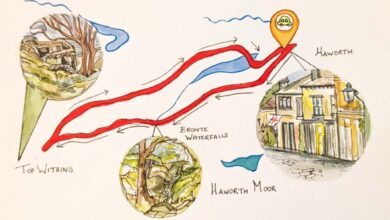Exploring Why We Have Different Seasons

Here in the temperate lands of Britain, after the colder, wetter, darker days of winter, we often cannot wait for the glimpses of warmer weather that comes with the advent of Spring. The days start to get longer, the colours start to come back to the garden and the moods start to lift.
Personally I love hiking in all seasons, in fact I enjoy doing my favourite walks in each season to savour it and experience it in various colours, weathers or its state of bloom. From the green lush summer walk to the more barren yet dramatic winter walk.
The four seasons of our temperate climate here, spring, summer, autumn and winter are not the same as what others experience at different parts of the globe.
Parts of the earth like the poles only have 2 seasons effectively, total darkness of winter and total daylight of summer. On the equator they have 2 seasons too but this is only seperated by a wet and a dry season.
Seasons are an intrinsic part of life on Earth, influencing everything from weather patterns to the behavior of plants and animals.
In the UK we may moan about all the rain, but without it all the Lake District and Yorkshire Dales would not be as gloriously green as it is.

Understanding the cyclic nature of seasons gives us insight into the natural world around us and how it shapes our lives. Let’s take a look.
Definition of Seasons
Seasons are divisions of the year marked by changes in weather, ecology, and daylight. These changes are primarily a result of the tilt of the Earth’s axis and its orbit around the Sun.
Each season, in our temperate part of the world, typically lasts about three months and is characterized by specific weather patterns, temperatures, and daylight hours.
Grasping the concept of seasons helps us appreciate the cyclical nature of our environment. It informs agricultural practices, influences cultural traditions, and affects our daily lives.
For instance, knowing when to plant crops or when to expect certain wildlife behaviors can be vital for sustainable living. Additionally, seasons contribute to the rich tapestry of human culture, shaping festivals, holidays, and even fashion trends.
The Science Behind Seasons
Earth’s Tilt and Orbit
When we look at a global map in our minds eye it is easy to see this spinning axis as the north pole at the very top and south pole at the very bottom. However, viewed in space and in reality, the spinning axis is tilted at an angle to or from the sun as it spins.

The earth is travelling through space, around the sun, at around 67,000 miles per hour. It is also spinning on the axis like a spinning top at around 1000 miles per hour.
It spins on this axis once in approximately 24 hours. It also take 365 days and a quarter to orbit around the sun. Every 4 years we have to account for that quarter of a day and reset with a leap year, yes, that extra day on 29 Feb.
The primary reason we experience seasons is due to this tilt of the Earth’s rotational axis, which is approximately 23.4 degrees.

So, with the tilt in mind, as the Earth orbits the Sun throughout the year, different parts of the planet receive varying amounts of sunlight at different times. For half the year’s orbit the north half of earth is tilted to the sun and for the other half the southern hemisphere is tilted nearer the sun.
So, this axial tilt is responsible for the seasonal changes we observe.
Spring and Autumn Equinoxes
The equinoxes, which occur in March and September, mark the points in the year when day and night are approximately equal in length, 12 hours of each. This is when the sun crosses the equator.
The word equinox comes from Latin for ‘equal night’.

Around the 20 March and approximately 22 September the centre of the sun is pointing at all parts of the earth for an equal 12 hours day and night. The sun is directly above the equator between the north and south hemisphere. However…
The Equilux
The earth is not flat, and we have an atmosphere that refracts, bends the light, so that is why, being away up from the equator on the equinox your sunrise and sunset app will not show an exact 12 hours between sunrise and sunset on these days.
We get an extra 10 minutes of light here in the UK on the actual equinox days because we see the sun rising before it comes physically over the horizon. The Equilux.
This means that the day we actually have 12 hours sunlight and 12 hours darkness is a few days before the spring equinox and a few days after the autumn equinox.
Places With 2 Seasons
If you look at the following illustration, you will also see that due to the Earth’s tilt the 2 poles are effectively in complete shadow or sunlight for 6 months of the year, switching over at the equinoxes. This results in 2 wildly different seasons.

However the equator too has 2 types of seasons and they are more a dry and wet season. When the sun is right over the equator at the equinoxes it is very dry. As it moves north and south to the Tropic of Cancer or Tropic of Capricorn it becomes a lot wetter and humid heat. This then becomes a wet, monsoon season.
Role of the Sun
The Sun plays a crucial role in influencing Earth’s climate and seasons. As an energy source, it warms the planet’s surface, drives weather patterns, and supports photosynthesis in plants. Seasonal changes in sunlight intensity and duration directly impact the temperature and ecological conditions in different regions.
For example, areas near the equator experience minimal seasonal variation due to consistent sunlight throughout the year, while polar regions experience extreme seasonal variations, with prolonged periods of light in summer and darkness in winter.
Effects of Seasons on Nature
Plant Life and Growth Cycles
The changing seasons significantly influence plant life and growth cycles. Seasonal shifts in temperature and sunlight dictate when plants bloom, grow, and enter dormancy. Most flowering plants and crops have adapted their life cycles to align with the seasons, ensuring they bloom at the best times for pollination and growth.
During spring, many plants emerge from dormancy, taking advantage of the increasing sunlight and moisture. In summer, they reach their peak growth, while autumn signals a time to prepare for the colder months, leading to colour changes and leaf drop. Winter can be harsh, but it also provides a necessary break for ecosystems, allowing for regeneration in the spring.
Animal Behaviour and Migration
Seasons also dictate the behavior of many animal species. Migration is a common response to seasonal changes, with birds and some mammals traveling vast distances to find food or suitable breeding grounds.
Many bird species migrate south during winter in search of warmer climates, while others return to northern regions in spring to breed.
A good example of this of birds in the UK is the swallow etc. I wrote about it with the sand martins too. In our winter they head to Africa and avoid our cold wet winters and in spring they come to the UK to breed and spend the summer here.
In addition to migration, many animals exhibit seasonal behaviors such as hibernation. Bears, bats, hedgehogs and dormice for instance, enter a state of torpor during winter months, conserving energy during times when food is scarce.

Seasons and Human Life
Cultural Celebrations and Traditions
Throughout history, seasons have profoundly influenced human culture, leading to the establishment of various celebrations and traditions.
Many cultures have festivals that correspond to agricultural cycles, such as harvest festivals in autumn or planting ceremonies in spring. These events not only mark seasonal changes but also foster community bonding and cultural identity.
In addition to agricultural observances, seasons inspire art, music, literature, and culinary traditions. For example, winter holidays often emphasize themes of family, warmth, and giving, while spring festivals celebrate renewal and growth.
Impact on Agriculture and Food Production
Understanding the seasons is critical for agriculture and food production. Farmers rely on seasonal weather patterns to determine when to plant and harvest crops.
Each region has its climate variations, which dictate the types of crops that can be cultivated successfully. For instance, some crops thrive in cooler spring weather, while others require the heat of summer.
In tropical areas, near the equator you have lots of warm sunshine and lots of heavy rain too. It is favoured for things like bananas, mangoes, pineapple and rice.
In temperate regions like our own in the UK the seasonal weather favours things like wheat, potatoes and barley.
Other nuances mean that mediterranean regions are better for grapes, olives, tomatoes and oranges.
Additionally, seasonal changes affect pest populations and disease cycles. Farmers must adapt their practices, employing strategies such as crop rotation and integrated pest management to ensure sustainable production throughout the year. This is an ongoing process due to the changing climate.
Climate Change and Its Impact on Seasons
Shifts in Seasonal Patterns
Climate change has begun to alter traditional seasonal patterns in many parts of the world. Rising global temperatures have resulted in earlier springs, hotter summers, and milder winters. These shifts can disrupt established ecological patterns, affecting everything from plant blooming times to animal migration schedules.
For example, some species may not adapt and evolve quickly enough to changing temperatures, leading to mismatches in food availability and breeding cycles. This can have cascading effects throughout ecosystems, as interdependent species struggle to adjust to the new realities brought about by climate change.
Scientists are closely monitoring these shifts to predict future impacts on biodiversity and ecosystem health.
Implications for Ecosystems
The consequences of changing seasons due to climate change can be profound. Altered growing seasons can lead to reduced crop yields, affecting food supply chains and economies worldwide. Additionally, ecosystems may face increased pressures from invasive species, as warmer temperatures create favorable conditions for new organisms to thrive.
Conservation efforts are crucial as we work to mitigate the impacts of climate change on seasons. Understanding the interconnectedness of ecosystems can help us develop strategies to protect vulnerable species and habitats. Sustainable agricultural practices, habitat restoration, and reducing greenhouse gas emissions are essential steps toward preserving the seasonal cycles that sustain life on Earth.
Conclusion
Seasons are a defining feature of life on Earth, affecting everything from weather patterns to cultural celebrations.
The Earth’s tilt and solar influence, reveals how interconnected our lives are with the natural world. The four seasons—spring, summer, autumn, and winter—each bring unique changes that impact plant and animal life as well as human activities.
Illustration drawings by Zoe X Art
FAQs
What causes the seasons?
Seasons are caused by the tilt of the Earth’s axis and its orbit around the Sun. This tilt results in varying angles of sunlight reaching different parts of the Earth throughout the year.
How do seasons affect plant growth?
Seasons influence plant growth cycles by dictating when plants bloom, grow, and enter dormancy. Warmer temperatures and longer daylight hours in spring and summer promote growth, while cooler temperatures in autumn and winter signal a time for rest.
Why are some regions more affected by seasonal changes than others?
Geographic location, climate, and proximity to the equator play significant roles in how seasons are experienced. Areas near the equator have less variation in seasons, while polar regions experience extreme seasonal changes.
What impact does climate change have on seasons?
Climate change alters traditional seasonal patterns, leading to earlier springs, hotter summers, and milder winters. These changes can disrupt ecological relationships and agricultural practices, affecting food security and biodiversity.
Source link



